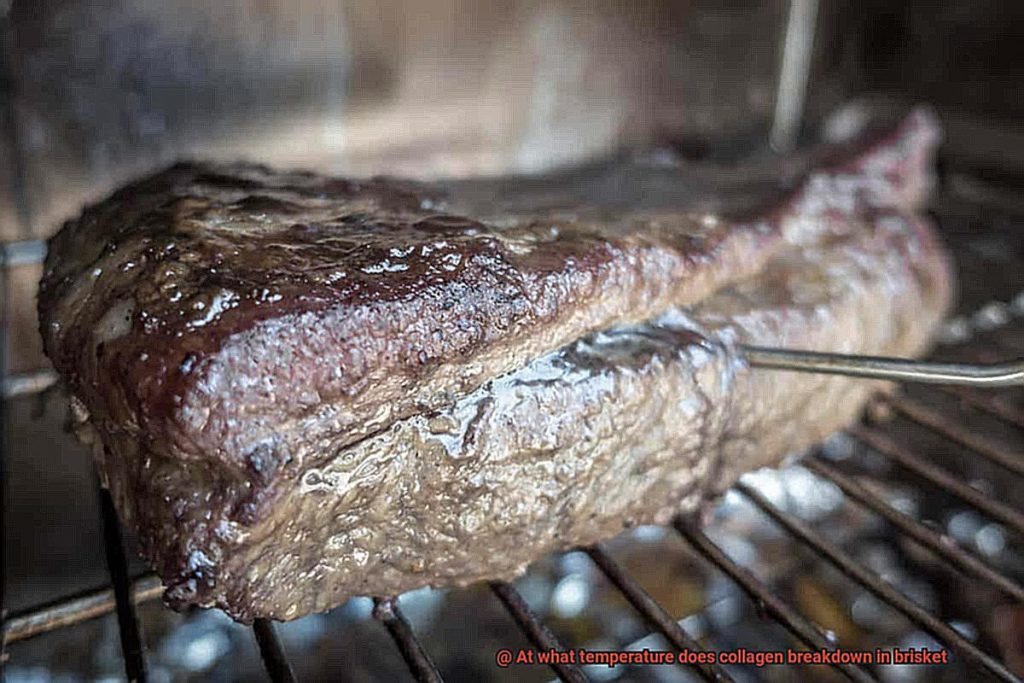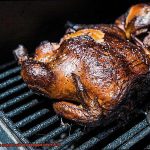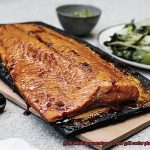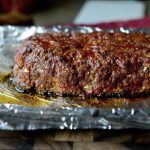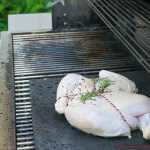Are you a meat lover who craves the juicy, succulent taste of brisket? If so, then you know that cooking it to perfection requires a delicate balance of time and temperature. One crucial factor that determines the tenderness and flavor of brisket is the breakdown of collagen – a protein found in the meat that gives it its structure and texture.
Collagen can be tough and chewy when it’s raw, but when it’s cooked at the right temperature for the right amount of time, it breaks down into gelatin – a moist and tender substance that’s responsible for the melt-in-your-mouth texture of a perfectly cooked brisket.
But what is the magic temperature range for breaking down collagen in brisket? Is there a single temperature or a range? And how do other factors like time and cooking method factor in?
Well, we’ve got all the answers for you right here. In this article, we’ll explore the science behind collagen breakdown in brisket, reveal the ideal temperature range, and share some tips and tricks to help you achieve that perfect, tender brisket. So get ready to don your apron, fire up your smoker or grill, and let’s dive into this delicious world.
Contents
What is Collagen?
Collagen is a vital protein that serves many purposes in our bodies and in our kitchens. It is a structural protein found in connective tissues such as bones, cartilage, tendons, and skin, providing strength and flexibility to these tissues. Collagen also plays a significant role in wound healing and maintaining healthy skin.
Type I collagen is the most prevalent form in the body and can be found in many connective tissues. But did you know that understanding collagen is crucial to cooking the perfect brisket?
Brisket is renowned for its tough texture due to the high amount of collagen present in the meat. However, when cooked correctly, this tough protein transforms into gelatin, making the meat tender and juicy.
During cooking, collagen breakdown occurs at around 160-170°F (71-77°C), creating a plateau effect where the internal temperature of the brisket seems to stop rising for several hours. This stage can be frustrating for grillers but is necessary for collagen breakdown to occur.
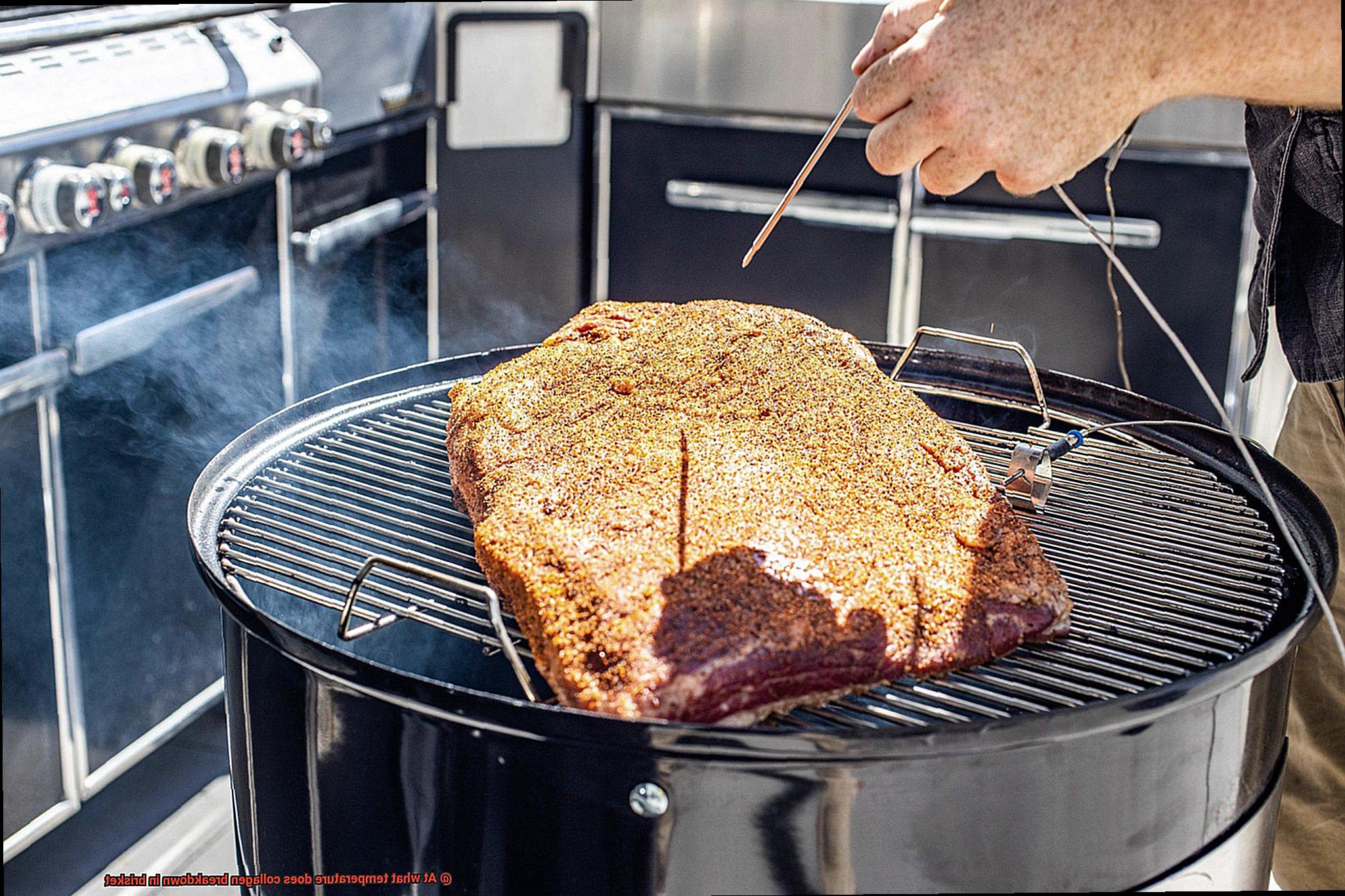
The breakdown of collagen is a slow process that requires both time and heat. Some grillers use the “Texas crutch” technique by wrapping their brisket in foil or butcher paper during this stage to speed up the process. However, it’s important to remove the brisket from the grill when it reaches an internal temperature of 195-205°F (90-96°C) to avoid overcooking, which can lead to dry and tough meat.
So next time you’re cooking up some brisket, remember the importance of understanding collagen and its behavior during cooking. With patience, time, and the right temperature, you can achieve a perfectly tender brisket that is bursting with flavor.
The Temperature at Which Collagen Breaks Down in Brisket
Achieving that tender and juicy meat requires time, patience, and most importantly, the right temperature range for collagen breakdown. Collagen is a protein found in the connective tissues of meat, including brisket. When cooked at a low temperature, collagen slowly breaks down into gelatin, creating a mouth-watering texture.
But what is the ideal temperature range for this breakdown to occur? The sweet spot is between 160°F and 205°F (71°C and 96°C), known as the “stall” or “plateau.” During this period, the meat’s internal temperature remains constant for several hours as moisture in the brisket evaporates, cooling the surface and slowing down cooking. This allows collagen fibers to break down and convert into gelatin, ultimately making the meat more tender.
The length of this stall period varies depending on several factors like the size of the brisket, cooking method used, and humidity levels in the cooking environment. Therefore, monitoring the process closely and regularly checking the internal temperature using a meat thermometer is essential.
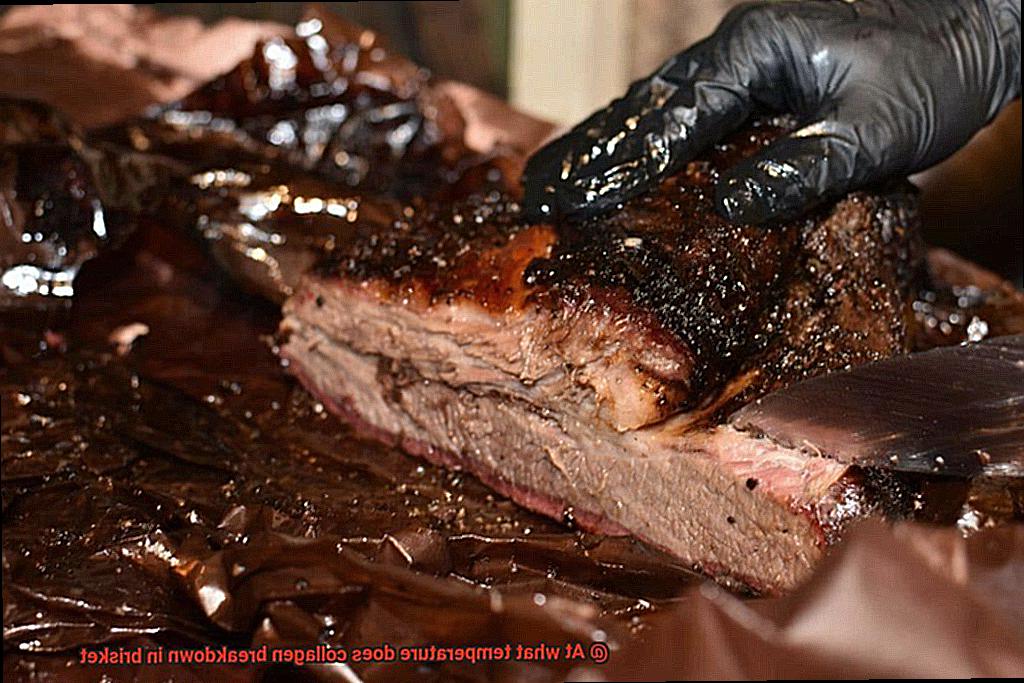
To achieve that perfect brisket, cook it low and slow at 225°F (107°C) until it reaches an internal temperature of at least 160°F (71°C). However, for an even more tender and juicy brisket, aim for an internal temperature between 190°F to 205°F (88°C to 96°C).
The Plateau and the Texas Crutch
Smoking a brisket is an art form that requires patience, practice, and knowledge. Two essential terms that every pitmaster should understand are the Plateau and the Texas Crutch. These two concepts are critical in achieving the perfect, mouth-watering brisket, but what exactly do these terms mean and how do they affect your smoking experience?
Firstly, let’s talk about the Plateau. This is a crucial stage in the smoking process where the temperature of the meat seems to stall or plateau for several hours. It’s a naturally occurring phenomenon that happens when collagen in the meat starts to break down. Collagen is a tough protein that gives meat its structure and texture, but when it breaks down, it converts into gelatin, making the meat tender and juicy. Though it may be frustrating to see your brisket’s temperature stagnate, don’t rush the process as patience is key.
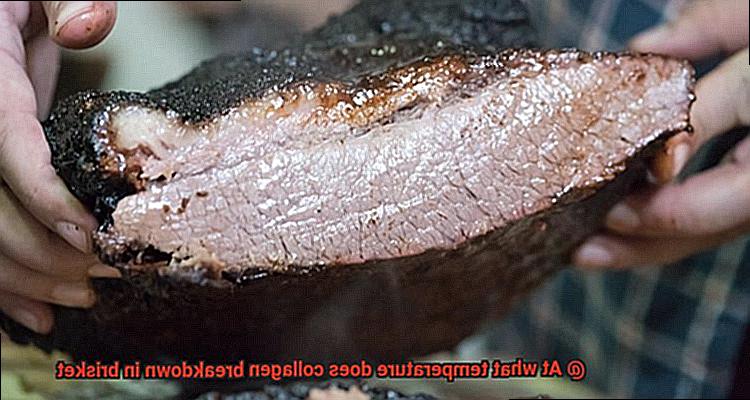
Secondly, let’s delve into the Texas Crutch. This technique is used to overcome the Plateau and speed up the cooking process without sacrificing tenderness or flavour. It involves wrapping the brisket in foil or butcher paper during the plateau phase, trapping moisture and heat. This can help push through the plateau and reduce overall cooking time. However, some purists believe that this technique may result in a loss of flavour and bark (the crispy outer layer of the brisket).
So which technique should you use? It depends on your personal preference and desired outcome. If you’re short on time or want to ensure that your brisket is cooked to perfection, then using the Texas Crutch may be right for you. However, if flavour and texture are your top priorities, then letting your brisket power through the Plateau naturally may be more suitable for you.
How to Achieve a Perfectly Cooked Brisket
Brisket is a mouthwatering cut of meat, but cooking it to perfection requires understanding the science behind collagen breakdown and implementing the right techniques. Here are five tips to help you create a tender and juicy brisket that will have your guests coming back for more.
Low and Slow Cooking Method
Cooking a brisket using low and slow heat is essential to achieving a tender texture. The ideal temperature for collagen breakdown is between 190-205°F (88-96°C). This slow cooking method allows the collagen in the meat to break down slowly, transforming into gelatin, which results in a mouthwatering final product. It may take anywhere from 12-16 hours to cook a brisket at a temperature of 225-250°F, but the time investment is well worth it.
Wrap Your Brisket
Wrapping your brisket in foil or butcher paper during the cooking process is crucial for retaining moisture and preventing the meat from drying out. Wrapping also speeds up collagen breakdown, resulting in a more tender texture. The wrapping should be done after the meat has reached an internal temperature of around 160-170°F.
Use a Meat Thermometer
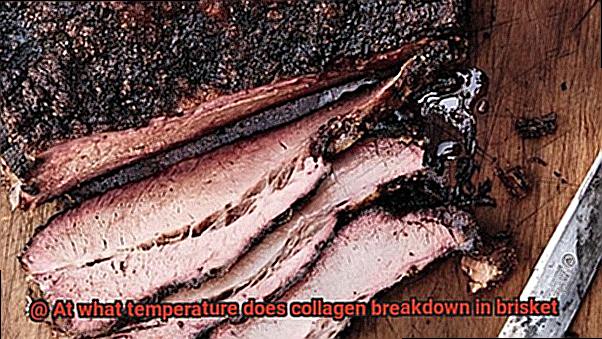
Using a meat thermometer is essential to ensure that your brisket reaches an internal temperature of between 190-205°F (88-96°C). Insert the thermometer into the thickest part of the meat for an accurate reading. This will prevent undercooking or overcooking, ensuring that your brisket has the perfect texture.
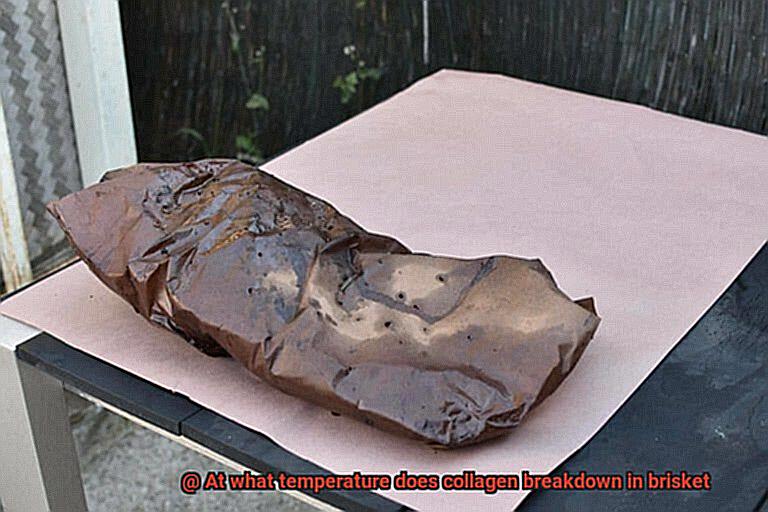
Rest Your Brisket
After cooking your brisket, allow it to rest for at least 30 minutes before slicing and serving. Resting allows the juices to redistribute throughout the meat, resulting in a more tender and moist final product. If you slice it immediately after cooking, the juices will escape, leaving the meat dry and tough.
Practice Patience
Achieving a perfectly cooked brisket requires patience. It can take several attempts to get it right, but don’t get discouraged. Keep practicing and experimenting with different techniques until you find the perfect recipe for your taste. Allow yourself time to learn and enjoy the process.
Overcooking Can Lead to Dry and Tough Meat
The culprit is most likely overcooking, which can cause the proteins in the meat to denature and squeeze out moisture. This is particularly true for tougher cuts like brisket, which contain a lot of collagen.
Collagen is a connective tissue that gives meat its structure, but it needs to be broken down properly in order for the meat to be tender. The ideal temperature for collagen breakdown is around 160-170°F (71-77°C), at which point it begins to convert into gelatin. Gelatin is responsible for giving slow-cooked meats their characteristic richness and mouthfeel.
However, if the temperature is too low, the collagen won’t break down enough and the meat will be tough. On the other hand, if the temperature is too high, the meat will dry out before the collagen has had a chance to break down. Therefore, it’s crucial to cook meats at the right temperature for the right amount of time.
When it comes to brisket specifically, cooking it low and slow at around 225-250°F (107-121°C) for several hours is key to achieving that tender texture we all crave. This allows the collagen to break down properly and create that melt-in-your-mouth experience. The process can take anywhere from 8-12 hours depending on the size of the brisket, so patience is a virtue.
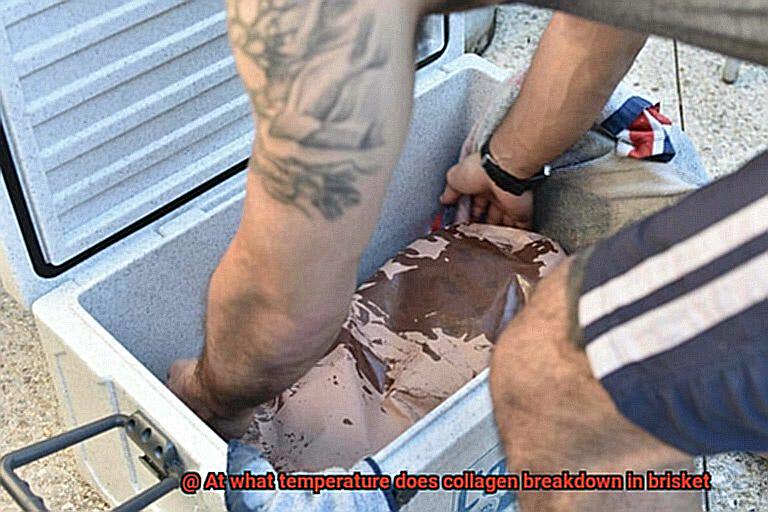
To prevent brisket from drying out during the cooking process, it’s recommended to wrap it in foil or butcher paper at some point. This helps retain moisture and ensures a juicy final product.
Resting the Brisket After Cooking
Brisket is a beloved cut of meat that requires utmost care and attention to achieve its signature tenderness and juiciness. While mastering the perfect temperature and cooking time is crucial, there’s one final step that can make all the difference: resting.
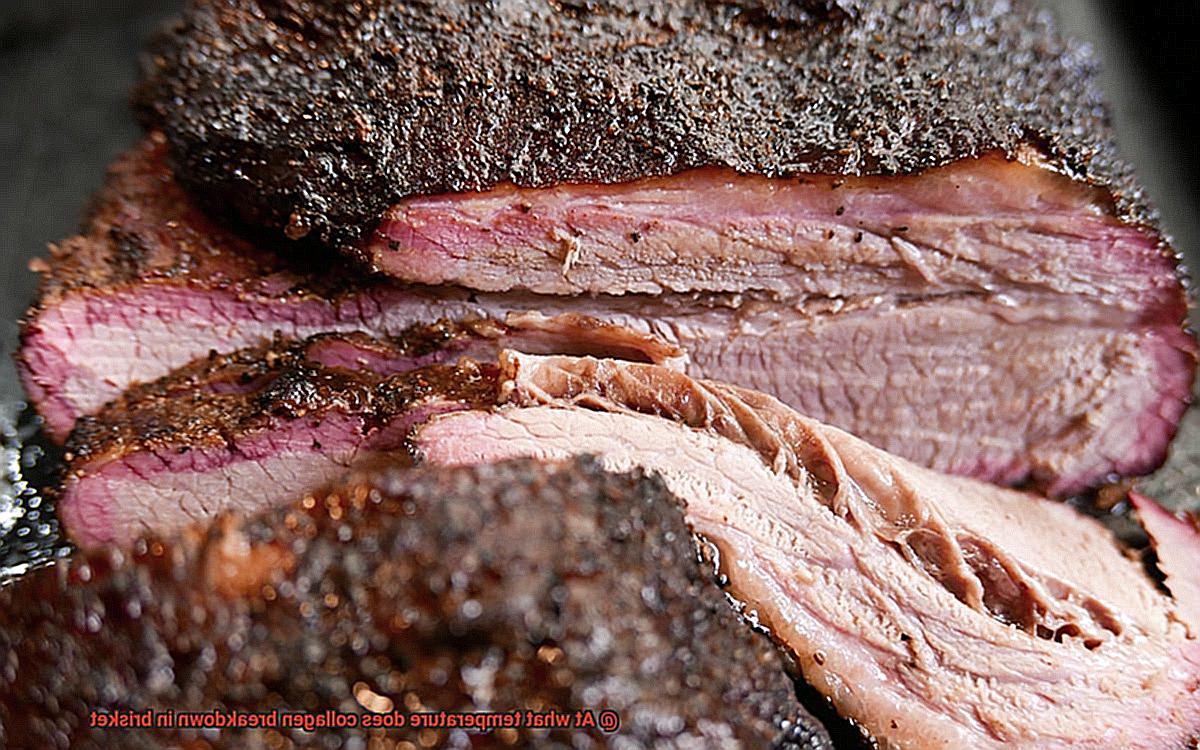
The science behind resting a brisket is simple yet essential. As the brisket cooks, the collagen slowly breaks down into gelatin, giving the meat its mouthwatering tenderness. However, slicing into the brisket right after cooking can cause all those precious juices to escape, resulting in a dry and tough end product.
To avoid this heartbreak, it’s crucial to rest the brisket properly. Remove it from the heat source and tent it loosely with foil for at least 30 minutes. For optimal results, wait up to an hour—this allows the juices to redistribute throughout the meat, ensuring each bite is packed with flavor and tenderness.
During this resting period, you’ll also notice that the internal temperature of the brisket continues to rise by about 5-10 degrees Fahrenheit. To ensure your desired level of doneness, remove the brisket from heat when it reaches an internal temperature of 195-205 degrees Fahrenheit.
Properly resting your brisket is just as important as cooking it correctly. By giving those juices time to redistribute, you’ll be rewarded with a tender and juicy final product that will undoubtedly make your taste buds sing. Don’t rush this crucial step—trust us, it’s worth the wait.
Health Benefits of Eating Brisket
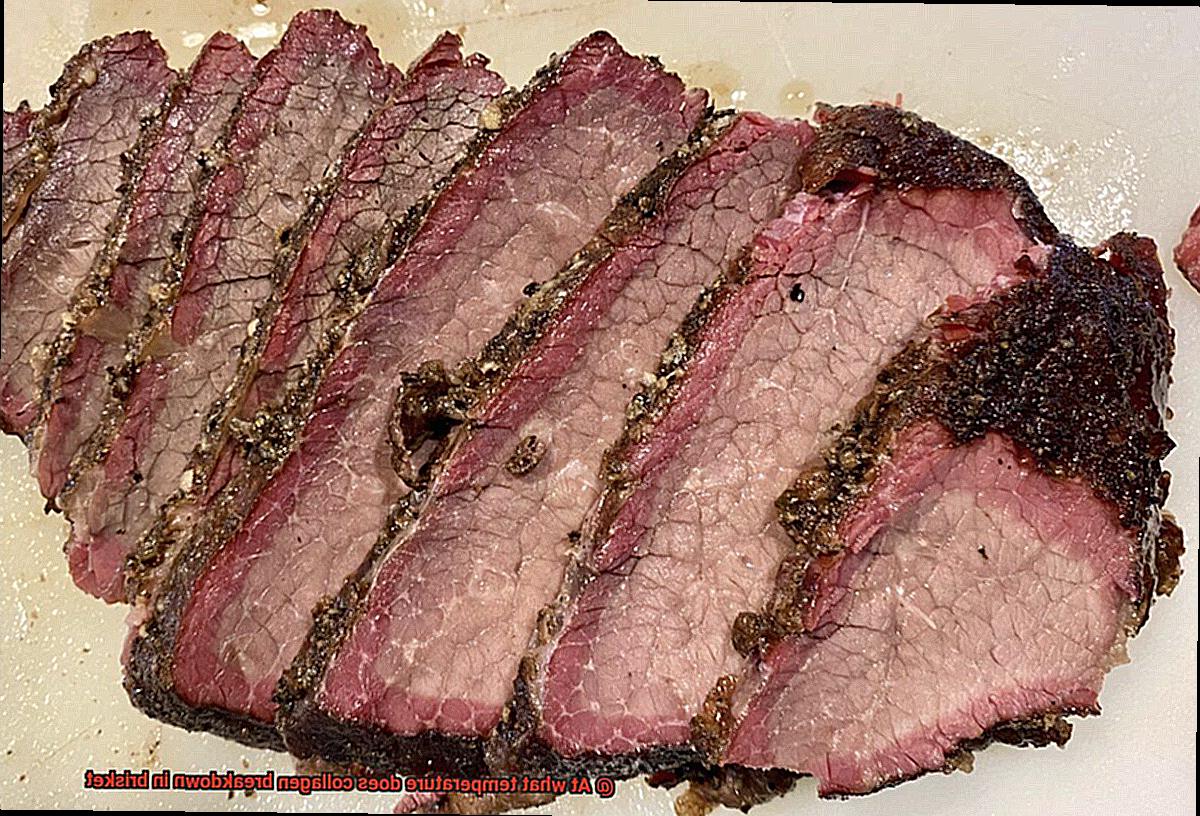
This popular cut of beef has several health benefits that are worth exploring.
Firstly, let’s talk about protein – the building blocks of our body. Brisket is packed with complete protein, meaning it contains all the essential amino acids our bodies need to function properly. Protein is crucial for building and repairing tissues in the body and can help with weight loss and muscle growth. So, if you’re looking for a protein boost, brisket is an excellent choice.
But that’s not all – brisket is also rich in important vitamins and minerals such as iron, zinc, vitamin B12, and selenium. These nutrients are vital for maintaining healthy blood cells, preventing anemia, and protecting against cancer and other diseases.
However, not all brisket is created equal. Highly processed or cooked in unhealthy oils or sauces can be high in saturated fat and sodium, which can contribute to health problems like heart disease. To maximize the health benefits of brisket, it’s essential to choose high-quality cuts of meat and cook them using healthy methods like grilling or baking.
To make your brisket dish even healthier, try incorporating some of these tips:
- Choose grass-fed beef: Grass-fed beef contains more nutrients like omega-3s and has less saturated fat than grain-fed beef.
- Use healthy cooking oils: Olive oil or avocado oil are excellent choices for cooking brisket as they contain healthy fats.
- Add vegetables: Brisket pairs well with vegetables like onions, carrots, and bell peppers. Not only do they add flavor and nutrition but also help balance out the meal.
Finally, don’t forget to rest the meat after cooking to allow the collagen to break down and redistribute juices throughout the meat. This will ensure a mouthwatering and tender end product that will make your taste buds sing while still being healthy for your body.
Tips for Grilling the Perfect Brisket
Grilling the perfect brisket can be a daunting task, but with the right tips and tricks, it can be a delicious success. One of the most important factors in achieving a tender and juicy brisket is temperature control. Here are five subtopics explaining why:
Understanding Collagen
Collagen is the connective tissue in meat that makes it tough and chewy. It is crucial to understand that collagen starts to break down at a specific temperature, which is key in making the brisket tender and juicy.
The Importance of Slow Cooking
The ideal temperature range for cooking brisket is between 225°F and 250°F. This temperature range allows for slow cooking, which is essential for breaking down the collagen in the meat. As the brisket cooks, the collagen begins to break down and convert into gelatin, which gives the meat a tender, melt-in-your-mouth texture.
Temperature Monitoring
To ensure that your brisket cooks evenly, it’s important to monitor the temperature throughout the cooking process. A built-in temperature gauge on your grill or smoker can help you keep a close eye on the temperature without having to constantly open and close the lid and cause heat fluctuations. This will help you avoid overcooking or undercooking the meat.
Adding Moisture
It’s important to keep your brisket moist during cooking to prevent it from drying out. You can add moisture by using a water pan or spray bottle to baste your brisket as it cooks. This helps regulate the temperature and prevents the meat from becoming too dry.
Letting it Rest
After cooking your brisket, let it rest for at least 30 minutes before slicing and serving. This allows the juices to redistribute throughout the meat, resulting in a more flavorful and moist finished product. During this time, cover your brisket with foil to keep it warm.
8OiaypcnXDk” >
Conclusion
In conclusion, mastering the art of cooking the perfect brisket is no easy feat. It takes time, practice, and a deep understanding of the science behind collagen breakdown. Collagen is the connective tissue in meat that gives it structure and texture. When cooked at low temperatures for an extended period, collagen slowly transforms into gelatin, creating a delectable texture that melts in your mouth.
The sweet spot for collagen breakdown in brisket lies between 160°F and 205°F (71°C and 96°C), which is commonly referred to as the “stall” or “plateau.” During this phase, the meat’s internal temperature stays constant for hours as moisture evaporates from its surface, causing it to cool down and slow down cooking. This process allows collagen fibers to break down gradually and convert into gelatin, resulting in tender and juicy meat.
To achieve a perfectly cooked brisket, use a low and slow cooking method at around 225-250°F (107-121°C) until it reaches an internal temperature of at least 160°F (71°C). Wrapping your brisket in foil or butcher paper during cooking can help retain moisture and speed up collagen breakdown. Once done, let your brisket rest for at least 30 minutes before slicing to allow juices to redistribute throughout the meat.
By following these tips and tricks, you’ll be able to create a mouth-watering brisket that will impress even the most discerning palates.

